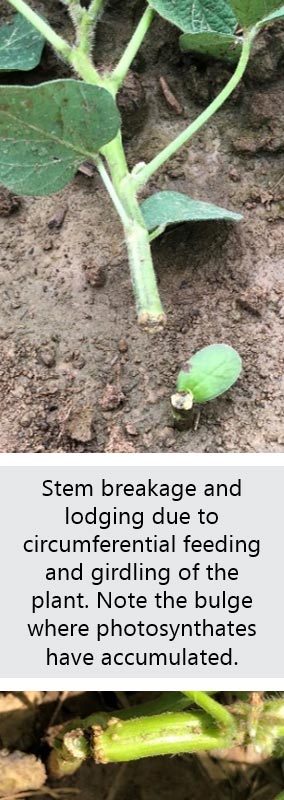Pest Facts
- Three-cornered alfalfa hopper, Latin name Spissistilus festinus, is part of the Membracidae, or tree hopper family.
- Both nymphs and adults have piercing-sucking mouthparts.
- It was first discovered and identified in 1831.
- Although it has a wide host range, it shows a preference for leguminous species and is an occasional pest of soybeans.
- Spissistilus festinus is established in the Southeastern and Mid-southern U.S.
- Adults typically fly within or just above plant canopies.
- Some studies suggest that populations tend to be greater in no-till or reduced tillage systems.
Identification
- Both adults and nymphs are wedge-shaped, and triangular when viewed from above.
- The “three corners” can be observed from the two points at each shoulder and one at the apex of the pronotum.
- Adult bodies are typically very small, 6-7 mm long.
- Coloration on mature adults range from green-brown to vibrant green.
- Nymphs have lighter colored dorsal spines to deter predators.
- Females are distinguishable from males because they have an ovipositor that deposits egg directly into plant material, whereas males have a red tint on the edges of their pronotum.

Life Cycle
- Eggs are laid within plant tissue either singly or in small clusters.
- Feeding typically starts in other crop and non-crop species before progressing to soybeans.
- Examples include cotton, clovers, dock, wild geraniums, sunflowers, tomatoes, etc.
- As the season progresses, the pest beings to move towards soybeans.
- Spissistilus festinus can overwinter as eggs in plant tissue or as adults under cover.
Damage
- Spissistilus festinus is a phloem feeder, meaning it sucks the sugary sap out of the plant.
- The removal of nutrients and sugars impede growth of the plant.
- Feeding can occur sporadically on tissues or in a ring around the circumference of the stem.
- The series of lateral punctures can cause a girdle, preventing the plant from transporting nutrients.
- Girdles diminish structural integrity of the targeted stems and petioles, making them more susceptible to their environment.
- Weakened plants may snap and lodge; severity depends on population and growth stage.
- Wounds caused by feeding can also predispose the plant to pathogen attack.

Management Considerations
- There is no universal economic threshold that has been developed for this pest.
- Some states recommend treatment after 50 percent or more of seedling plants are girdled during early infestation.
- During reproductive stages, a treatment threshold of one hopper per sweep (100 per 100 sweeps) is sometimes recommended.
- In Tennessee, treatment for hoppers is recommended when 10 percent or more of plants less than 10-12 inches tall are infested.
- Consult your local university recommendations for best management practices.
References
- Beyer, B. A., Srinivasan, R., Roberts, P. M., & Abney, M. R. 2017. Biology and Management of the Threecornered Alfalfa Hopper (Hemiptera: Membracidae) in Alfalfa, Soybean, and Peanut. Journal of Integrated Pest Management, 8(1).
- Stewart, S., Thompson McClure, A., & Russ, P. (n.d.). Threecornered Alfalfa Hopper. Retrieved from UT Extension.
Author: Madeline Henrickson
July 2019
The foregoing is provided for informational use only. Please contact your Pioneer sales professional for information and suggestions specific to your operation. Product performance is variable and depends on many factors such as moisture and heat stress, soil type, management practices and environmental stress as well as disease and pest pressures. Individual results may vary. Pioneer® brand products are provided subject to the terms and conditions of purchase which are part of the labeling and purchase documents.